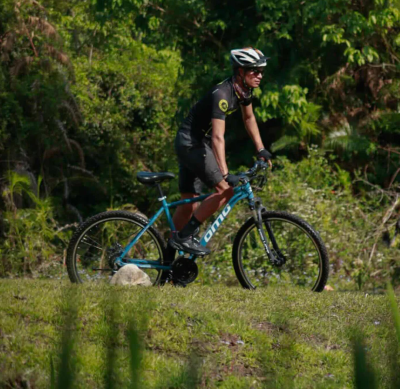Some of the general principles that apply to this sport include flexibility in the physical terrain in which the cyclists operate, elevation and rapid dips. One cannot underestimate the importance of your bike’s gears, these help in managing such challenges as effectively as you possibly can. Understanding how mountain bike gear works can enhance the experience of the riders especially when it comes to controlling the bicycles.
This guide describes the various gear options which are available on today’s mountain bikes such as the traditional 3x (three-chainring) and modern 1x (single-chainring). We’ll also be looking into the advantages of each setup to help you decide what conforms best with your riding preferences.
Understanding How Mountain Bike Gear Works
The number of gears on a mountain bike setup is usually presented as “3×7” or “1×12,” and so on. The first number always indicates how many chainrings are in front and the second number points to how many cogs are in the rear cassette. Consequently, a 3 x 7 system means that the front crank has three chainrings and the rear wheel has seven cogs offering the rider 21 possible gear options.
That makes it possible to better control your mountain bike gear over different surfaces, including steep pitches up or down, and flat ground.
The Mechanics Behind Mountain Bike Gears
The Mountain bike gears are designed to vary the rate and torque with which the bike moves offering one a required power about a certain given encounter. Generally:
- Lower gearing is for going uphill, which gives much more torque with less effort.
- Higher gears are for use when there are long stretches of flat land or, at least, when there is a gentle descent.
The force that is needed to turn the pedals and the speed that can be attained is simply set by the selection of the front chain ring and the rear cog combination.
Types of Mountain Bike Gear Setups
Let’s look at how each type of setup works, with a focus on understanding the advantages and limitations of each.
- 3×7, 3×8, 3×9: Triple Front Chainring Setups
- 3×7 (21 speed), 3×8 (24 speed) and 3×9 (27 speeds) all have three chainrings at the front and numerous cogs at the rear.
- These configurations provide body through a multitude of gears providing the rider general flexibility particularly when having to overcome steep inclines and flat grounds.
- Pros: A wide gear range that makes it possible to tackle varied terrain of varying inclines as well as types of terrains. Suitable for beginners especially those who are involved in mountain bike riding or for those who encounter steep hills often.
- Cons: A little weight more as there are more elements which makes it a little more difficult to maintain as well as to design. There is, however, the cross-chaining effect (when the chain is stretched at an angle) which over time leads to wear.
Triple chainring setups have in the past been preferred because of their flexibility. But over the years many riders have resorted to simpler gearing patterns as the sport of mountain biking has developed.
- 2×10 and 2×11: Double Front Chainring Setups
- The 20-speed or 2 x 10 and the 22-speed or 2 x 11 have two front crankset chain rings and a long-crankset rear cassette.
- This setup provides the extension of a number of gears while minimizing weight and componentry complexity in comparison with triple-chainring arrangements.
- Pros: It provides a good balance between the extent of the gearing up and ease of address from gear to gear. If a rider doesn’t want the extra work of a triple setup but still needs the shifting flexibility, this is perfect for them.
- Cons: Is also not free from extra work and mass compared to a 1x configuration but is way better than a 3x configuration.
- 1×10, 1×11, 1×12: Single Front Chainring Setups
- 1×10, 1×11 and 1×12 are common these days in most modern mountain bikes used in cycling campaigns around the world. Neither of these models uses dual chainrings up front but comes equipped with a mountain bike-like wide-range cassette in the back.
- Pros: It has also pointed out that single-chainring would be appropriate for mountain bikes due to its simplicity. Since it only has one shifter, it is easy to use, lightweight and easy to maintain. There is no matter cross chaining and with fewer parts to go together, there will be fewer mechanical problems.
- Cons: While 1x thereby offers a slightly shorter range of gears than 2x or 3x, new wide-range cassettes (especially 1×12) offer reasonable flexibility for ascending and descending.
One chainring setup is best for those who think less of the mass, few shift system and it is easily manageable. For instance, for riders searching for quick shift gear systems, positive aspects of how a mountain bike gear in these configurations unveil how to maximize the MTB’s performance on trails.
Choosing the Right Gear Setup for Your Riding Style
Picking the right gear setup off a mountain bike is made easier when you’ve understood how the gear of a mountain cycle works.
- Terrain:
- If you go on rough roads where there are several climbs then a 3rd or 2nd option is better as you have hob more gears.
- On more flowing or rooty trials a 1x drive certainly provides a cleaner, faster experience.
- Skill Level:
- It might be well suited to beginners because it offers an extra range of something like a 3x setup so that they can get used to gear shifting and all that nonsense.
- Advanced and enduro riders typically like a 1x drive system because you spend more time on the bike rather than shifting gears.
- Maintenance:
- The 3x setups, although much more flexible, have more issues in terms of maintainability due to the extra bits.
- The 1x setups are easy to manage and are usually not very heavy; for this reason, professional mountain bikers prefer the strand.
Common Questions About Mountain Bike Gears
Q1: Why Are 1x Setups So Popular?
Since 1x setups allow for fewer components on the bike there is less weight and less maintenance needed which is perfect for mountain biking. As such they let riders focus on the trail without the bother of front shifting.
Q2: What Does a Wide-Range Cassette Do?
A wide-range cassette on a 1x setup provides a range of gears for both climbing and descending. The largest cogs are great for steep climbs, while the smaller cogs are ideal for maintaining speed on flat or downhill sections.
Q3: How Do I Know Which Gear to Use?
In general, low gears produce more effort for lifting, whereas high gears work best when there are flat terrains or decadencies. Learning how mountain bike gear works means you can also predict the gear that fits the terrain of the adventure ahead.
Final Thoughts on Mountain Bike Gear
Regardless it is your first day biking or you have been biking for the last several years, it is crucial that you get to understand how the different Mountain Bike Gear operates. All the 3x 2x or even 1x are not wrong at all every one of them has its own merits and depending on the type of terrine one wants to ride or the kind of ride one wants then the set-up is the best.
When you know how each of the mountain bike gears operates, you can have a great ride in any mountainous area and also make every ride a good one.



